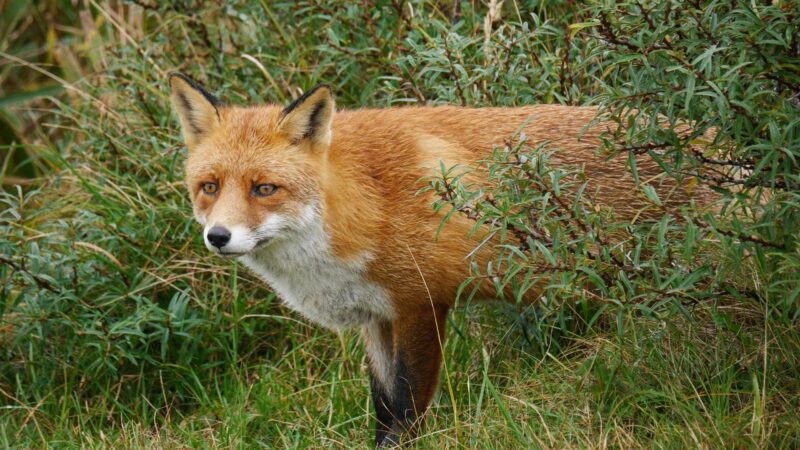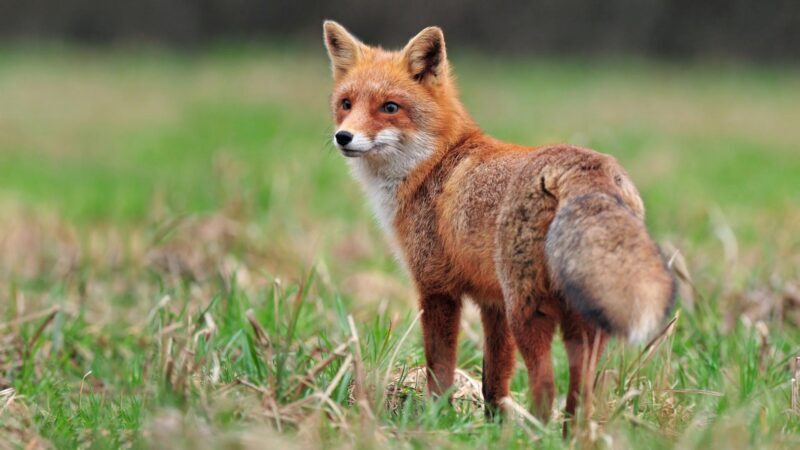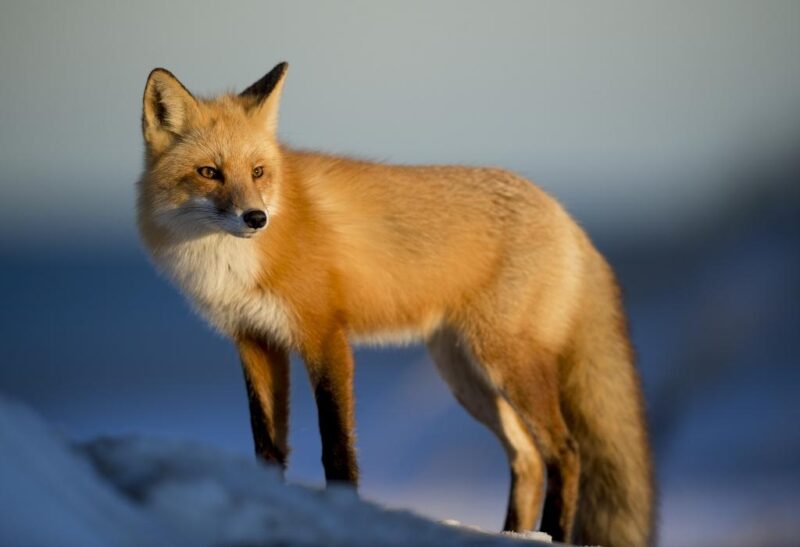Throughout the years, foxes have always been regarded as intelligent creatures that only belong in the wild. However, today, these wild animals are now kept as pets by humans.
What is the truth about foxes? There are many truths about facts, but the most intriguing is that foxes use the earth’s magnetic field to catch their prey. On top of that, these wild beasts can make 40 different sounds, including howling, barking, whimpering, growling, and many more!
In this article, we will share with you more facts about Foxes that you may still not know about today. So, let’s get it started!
Table of Contents
13 Facts About Foxes You May Not Know
1. Some People Keep Foxes as Pets

Thanks to the Belyaev experiment, domesticated foxes do exist. Unlike the tamed fox that has learned to abide with humans, a domesticated fox is bred to be submissive from birth.
Big-eared fennec foxes (Vulpes zerda) are among the most popular variety of pet foxes. These foxes are discreetly bred throughout the U.S. and are readily obtainable for a couple of thousand dollars.
Fennec foxes are small in size with a long life expectancy, and a sweet personality, making them a good option as a pet fox. However, they may not be suited for homes with children or other pets since they get nippy.
Other foxes breed that can be pet according to a source, are the following:
- Silver fox
- Gray fox
- Kit fox
- Swift fox
Related: Can You Have a Pet Fox? | Do They Make Good Pets?
2. Foxes Use the Earth’s Magnetic Field
Researchers have discovered that foxes use the earth’s magnetic fields to calculate their prey’s distance and direction. They use this to their benefit when pursuing small animals found in deep snowy environments and high grass.
They use the magnetic field to leap at the right moment and capture their prey successfully. At first, the fox prowls forward, listening to the sound of its prey and searching for the perfect spot where the sound’s angle hits its ears, matching the Earth’s magnetic field’s slope.
At that site, the fox understands that it is a set length away from its prey and knows precisely how far to jump to pounce on its prey.
Here’s how this works—foxes consider the earth’s magnetic field as a shadow in their visual field. So, when the shadow aligns with the prey’s sound, they start to pounce.
3. Foxes Are More Like Cats Than Dogs

Although foxes are part of the Canidae family, along with dogs, they have more in common characteristics with cats. Some of these similarities are the following:
- Foxes are the lone Canidae family member that can climb trees and, like cats, they occasionally sleep in branches of trees.
- Similar to cats, foxes are nocturnal animals—which means they are highly active at night. Their upright pupils allow them to see clearly in dim light or dark.
- Cats and foxes convey the same hunting technique—they both hunt and pounce on their prey.
Related: Are Foxes Dogs or Cats? | Information and Guide
4. The Red Fox Is the Most Common Fox
The red fox (Vulpes vulpes) is the biggest of the true foxes and the most widely circulated member of order Carnivora. This species is present across the whole Northern Hemisphere, including:
- North America
- Europe
- Asia
- North Africa
The red fox is documented as the least concern by the International Union for Conservation of Nature (IUCN). Its scope has advanced alongside human development.
Related: Red Fox Babies | All You Need to Know!
5. Foxes Live In Underground Dens

Foxes dig out dens to ensure having a safe underground space used for raising fox cubs, better known as kits. In urban areas, the lairs are typically located under sheds.
Nonetheless, you can also find them among bushes, tree roots, and railway barriers. Foxes will often visit these underground dens throughout the year for shelter.
When the vixen delivers her pups — a litter of foxes can vary between one to 11 pups and live in the den jointly for seven months until the kits grow up. These underground dens provide foxes the protection they need against predators, such as bears, coyotes, and wolves.
6. Foxes Are Good Parents
Foxes are good parents—particularly the males since they are doting and tolerant. They enjoy playing and messing around with their pups.
While the pups are still young, the father hunts every single day to provide food to the den for the cubs and their mom. The parents also ensure no harm will come to their cubs and fight those they feel are threats to their kits.
7. Foxes Are Smelly

Foxes are smelly creatures. They have a sickly, stale scent coming from the glands, found at the base of their tails. Fox urine, in particular, has a repulsive skunky odor caused by two sulfur-containing compounds, 2-phenylmethyl methyl sulfide, and Delta 3-isopentenyl methyl sulfide.
Foxes have a sharp sense of smell, which plays a fundamental role in the vulpine community. They possess glands that generate various chemical compounds, mirroring the diversity of fox scent applications.
For instance, the gland on the top of their tail, known as the supracaudal (violet) is used for intra-species signaling, scent-marking, and contributing to the repulsive smell of foxes in particular.
Meanwhile, the glands surrounding their chin are used when foxes rub their head on the ground or jaws vegetation. In addition, droppings and urine are deliberately deposited around their territory to claim ownership of that area, letting other individuals know about it.
8. Climate Change Is Hurting Arctic Foxes
Arctic foxes are currently facing multiple threats from climate change—sea ice and tundra habitat are diminishing, and lemming preys are becoming scarce in some areas. Furthermore, foxes also face increased competition and banishment by the red fox, which is pushing northward as temperatures warm.
To understand how these circumstances affect foxes, you may refer to the following:
Sea Ice and Tundra Habitat Loss
Since sea-ice habitat supplies essential winter food for Arctic foxes, particularly in low lemming periods, the loss of sea-ice searching grounds will decrease the probability of winter survival and reproductive conquest for Arctic foxes.
Lesser Lemming Prey
Arctic foxes depend heavily on lemmings for food, and climate change’s influence on lemmings can have a deep impact on foxes. During the winter, lemmings live in areas under snow, providing insulation from the cold, access to plant foods, and protection from predators.
If snow conditions are exemplary, lemmings thrive and even get a head start in growing young. However, rising temperatures and varying humidity in recent years created thawing and icing cycles in winter, resulting in poor snow conditions for lemmings.
These poor snow situations have dulled the lemming population cycles, forming a new imprint where lemmings will never attain their prime numbers.
The Competition: Red Fox vs. the Arctic Fox
The Arctic fox has a ferocious competitor, the red fox. This fox is dominant and bigger in build than the Arctic fox.
The red fox can kill or displace the Arctic fox in places of overlap. This means the two fox species can clash as they are both heading northward due to climate change affecting their respective natural habitat.
Warming is transforming the tundra into shrublands—which is much loved by red foxes. Global warming-related declines in lemming populations also lower lemming grazing strain on the tundra.
This circumstance favors the shrublands that rouse the northward incursion of red foxes.
9. Foxes Make 40 Different Sounds
Foxes can create up to 40 varying sounds. The most apparent is their scream-like cry, which sends a shiver up to your spine when hearing it.
Gekkering—a series of growling-like chatter, is also the most typical noise made by foxes, particularly in a brawl. When another fox invades its territory, foxes gab loudly back and forth to protect their home.
Part of foxes large repertoire of vocalizations include:
- Barks
- Howls
- Growls
- Whines
- Wails
- Shrieks
- Squeaks
- Whimpers
Related: Why Do Foxes Scream at Night? | Information and Facts!
10. Foxes Are Solitary
Unlike their canine relatives, foxes are lone animals. They prefer to hunt and rest alone, except when they are busy tending their kits in their lair.
11. Foxes Have Impeccable Hearing Abilities

Foxes have impeccable hearing abilities that help them recognize their prey underground. What’s even more fascinating is that foxes use the Earth’s magnetic field to find their prey. Combine that with their sharp sense of hearing, making them fierce predators.
12. Foxes Are Extremely Playful
Foxes are extremely playful animals. They like to play with other animals and other foxes. They even occasionally steal balls from backyards and golf courses to play with it.
13. Foxes Are Related to Dogs

Foxes are a part of the Canidae family, making them canines. They’re closely related to dogs and wolves.
Summary
Foxes are fascinating animals—this is why, although they are naturally wild animals, there are still people who want to pet them.
We hope that this guide has given you some knowledge about foxes that you might not have known yet and helped you decide if keeping a fox pet is for you or not.
List of Sources
Trut, L. N., Kharlamova, A. V., Herbeck, Y.E. (2020). Belyaev’s and PEI’s Foxes: A Far Cry. Trends Ecol Evol.
Saunders, D. A. (1988). Red Fox (Vulpes vulpes Desmarest). State University of New York, College of Environmental Science and Forestry.
What does the fox actually say? (2013). The University of Melbourne.
